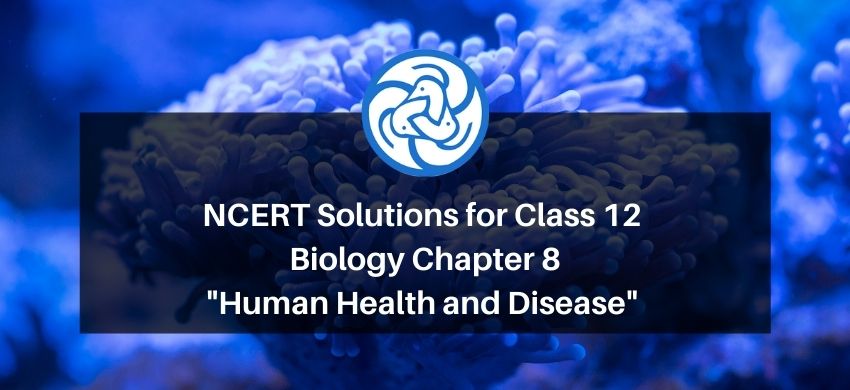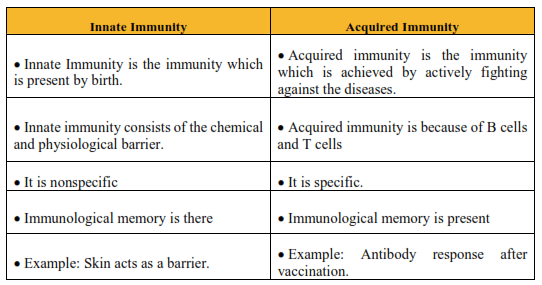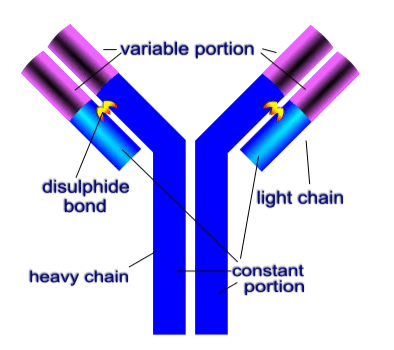
NCERT Solutions for Class 12 Biology Chapter 8 Human Health and Disease PDF
Hey, are you a class 12 student and looking for ways to download NCERT Solutions for Class 12 Biology Chapter 8 Human Health and Disease PDF? If yes. Then read this post till the end.In this article, we have listed NCERT Solutions for Class 12 Biology Chapter 8 Human Health and Disease in PDF that are prepared by Kota’s top IITian Faculties by keeping Simplicity in mind.
If you want to learn and understand class 12 Biology Chapter 8 "Human Health and Disease" in an easy way then you can use these solutions PDF.
NCERT Solutions helps students to Practice important concepts of subjects easily. Class 12 Biology solutions provide detailed explanations of all the NCERT questions that students can use to clear their doubts instantly.
If you want to score high in your class 12 Biology Exam then it is very important for you to have a good knowledge of all the important topics, so to learn and practice those topics you can use eSaral NCERT Solutions.
In this article, we have listed NCERT Solutions for Class 12 Biology Chapter 8 Human Health and Disease PDF that you can download to start your preparations anytime.
So, without wasting more time Let’s start.
Question 1. What are the various public health measures, which you would suggest as safeguard against infectious diseases?
Solution. Various public health measure to safeguard infections are:
• Maintainance of public and personal hygiene
• Practising immunisation.
• Eradication of certain deadly diseases such as small.
• Creating awareness about the various vaccines.
Question 2. In which way has the study of biology helped us to control infectious diseases?
Solution. Biology has given us a lot of information such as awareness about the preventive measures for a disease. A lot of vaccines have been developed by understanding the method of infection by the micro-organism. People are immunised against several deadly diseases such as smallpox. In case the disease occurs, antibiotics help in keeping the spread of infection in control.
Question 3. How does the transmission of each of the following diseases take place?
(a) Amoebiasis
(b) Malaria
(c) Ascariasis
(d) Pneumonia
Solution. (a) Amoebiasis: Ingestion of quadrinucleate cysts of Entamoeba histolytica found in contaminated food and water results in amoebiasis. The cysts are found in faeces of patients, which enters food and water.
(b) Malaria: It is a vector-borne disease where Plasmodium (a malarial parasite) is carried by female Anopheles mosquito and transmit the disease from patient to a healthy person when a mosquito bites the latter.
(c) Ascariasis: Ingestion of contaminated food and water infected with embryonated eggs of Ascaris worms.
(d) Pneumonia: It is an airborne disease transmitted by the sputum and droplets released when a patient coughs.
Question 4. What measures would you take to prevent water-borne diseases?
Solution. Waterborne diseases can be prevented by following methods:-
• Consumption of pure drinking water.
• Periodic disinfection of waterborne diseases.
• Maintaining personal and public hygiene.
Question 5. Discuss with your teacher what does 'a suitable gene' means, in the context of DNA vaccines.
Solution: Suitable gene is the segment of DNA which is inserted into the host. This DNA forms the infection-causing proteins of the micro-organism. The antibodies are generated by our body against these proteins hence giving us immunity for a future encounter with the disease-causing microorganism.
Question 6. Name the primary and secondary lymphoid organs.
Solution. Primary lymphoid organs are:
• Bone marrow
• Thymus
The secondary lymphoid organ includes:
• Spleen
• Tonsils
• Peyer’s patches
• Lymph Nodes
• Vermiform appendix
• Mucosa-associated lymphoid tissue (MALT)
Question 7. The following are some well-known abbreviations, which have been used in thischapter. Expand each one to its full form:
(a) MALT
(b) CMI
(c) AIDS
(d) NACO
(e) HIV
Solution. (a) MALT-Mucosa associated lymphoid tissue
(b) CMI - Cell-mediated immunity
(c) AIDS- Acquired immunodeficiency syndrome
(d) NACO-National AIDS control organisation
(e) HIV-Human immunodeficiency virus
Question 8. Differentiate the following and give examples of each:
(a) Innate and acquired immunity
(b) Active and passive immunity
Solution: (a) Innate and acquired immunity

(b) Active and passive immunity

Question 9. Draw a well-labeled diagram of an antibody molecule.
Solution.

Question 10. What are the various routes by which transmission of human immunodeficiency virus takes place?
Solution. The routes by which transmission of HIV takes place is:
• Sexual contact with an infected person
• Use of contaminated needles for drug abuse.
• Transfusion of infected blood.
• Infected mother to fetus.
Question 11. What is the mechanism by which the AIDS virus causes deficiency of the immune system of the infected person?
Solution. • HIV enters the body through macrophage.
• The viral RNA genome forms viral DNA using reverse transcriptase
• Viral DNA enters the host cell to produce viral particles and turns the macrophage into the viral factory.
• After infecting macrophages, the virus infects T helper lymphocytes and produce more virus particles.
• T helper lymphocytes start decreasing in number.
• The decrease in the number of T lymphocytes makes the person susceptible to infections. This is known as acquired immunodeficiency.
Question 12. How is a cancerous cell different from a normal cell?
Solution. A cancerous cell does not have the property of contact inhibition, and hence, they divide uncontrollably causing tumours.
• Cancer cells differentiate, whereas normal cell does not undergo differentiation.
• Cancer cells can undergo metastasis while this property is absent in normal cells.
Question 13. Explain what is meant by metastasis.
Solution. Metastasis is the property of tumour cells to lodge in various parts of the body and cause another set of tumour cells. It is the transfer of malignant tumour from a primary to the secondary region of a body through lymph or blood. The cancerous cells migrate through blood or lymph to other regions of the body after getting released from the malignant tumour, which accumulates to form secondary tumour growth. The migration and settling of malignant tumour breaks are called metastasis.
Question 14. List the harmful effects caused by alcohol/drug abuse.
Solution. Harmful effects of drug abuse are:
• Recklessness, vandalism, abnormal social behaviour
• Mental depreciation and disorders in psychological behaviour.
• Excessive abuse of alcohol leads to coma and death.
• Respiratory failure, heart failure, and cerebral hemisphere.
• Financial distress and mental stress.
• Serious disease such as AIDS, hepatitis B.
• Nervous damage and liver cirrhosis.
• Masculation in females and female characters in males due to anabolic steroids.
• Stunted growth
Question 15. Do you think that friends can influence one to take alcohol/drugs? If yes, how may one protect himself/herself from such an influence?
Solution. Yes, friends can influence one in taking alcohol/drugs. Following measures can be taken:
(i) Avoid undue peer pressure.
(ii) Get counseling from a counselor.
(iii) Practice good habits.
(iv) Seek medical help.
Question 16. Why is that once a person starts taking alcohol or drugs, it is difficult to get rid of this habit? Discuss it with your teacher.
Solution. Upon taking alcohol or drugs the person feels either energetic or calm. This happens due to the sudden increase in neurotransmitters. When these drugs are withdrawn the person feels uneasiness hence feel like consuming it again, making it difficult to quit. This tendency of the body to manifest a characteristic and unpleasant feeling is referred to as withdrawal syndrome.
Question 17. In your view what motivates youngsters to take to alcohol or drugs and how can this be avoided?
Solution. Youngsters are in a very vulnerable state of mental and psychological development, the reasons the fall in prey of drug and alcohol abuse are:
Curiosity to experiment which later becomes an escape to facing the problem.
There is a perception that teenagers feel very progressive if they consume alcohol or smoke.
Consumption of drug is common in order to cope up with exam pressure.
Television, movies, newspaper promotes the perception that consumption of alcohol is part of a good lifestyle.
Use of the drug is also common in the cases where it is unsupportive and unstable family structure and family pressure.
Also Read,
Class 12 Chemistry Notes Free PDF Download.
Class 12 Biology Book Chapterwise Free PDF Download.
Class 12 Biology Exemplar Chapterwise Free PDF Download.
If you have any Confusion related to NCERT Solutions for Class 12 Biology Chapter 8 Human Health and Disease PDF then feel free to ask in the comments section down below.
To watch Free Learning Videos on Class 12 Biology by Kota’s top Doctor Faculties Install the eSaral App
